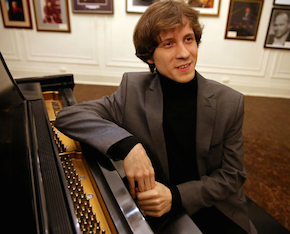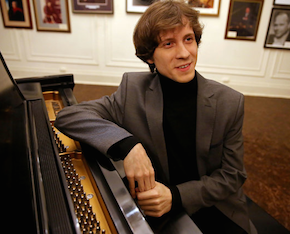
Photo by Andrea Mohin
After a spectacular victory at the 2005 International Chopin Competition, Rafał Blechacz has been in high demand as an interpreter of Chopin. He was just recently awarded the prestigious Gilmore Artist Award, perhaps the most coveted award for a concert pianist. His career has been on a stratospheric trajectory and his recent recital at SFJAZZ, presented by San Francisco Performances, was a major event.
Blechacz opened the evening with a layered rendition of Bach’s Italian Concerto. The pianist emulated the contrasting colors of the forte and piano manuals of a two-manual harpsichord of Bachʼs era through deliberate use of the una corda pedal. The dry acoustics of the auditorium accentuated the contrast enhancing the intimate purity of the sound.
Blechacz further explored contrasting colors by using different parts of the pianoʼs hammers. He produced subtle gradations of colors within each of the layers to illustrate nuances. Rejecting the sustain pedal, he meticulously trimmed away any blurriness that might contaminate the purity.
The Presto movement of the concerto was taken at a slightly more relaxed pace than we often hear these days, but it had a sense of barely contained enthusiasm, full of jabs and punches, while keeping the music leaning forward throughout the movement. The atmosphere was gregarious and even boisterous at times.
The Beethoven Sonata Op.13 “Pathétique,” in contrast, was introspective, with deliberate phrasing and extended rests to build tension. Blechacz gave a striking example of the importance of silence in music through the spacing of his phrases. (As Claude Debussy said, “Music is the space between the notes.”)
His artistry has only deepened ... In this recital, Blechacz embraced the audience closer, and whispered into their ears. It was seduction at its sweetest.
With all this delicacy, I longed for a more outward projection of the sound in this piece, relying less on the una corda pedal. Blechaczʼ approach is highly refined, demanding that the audience focus on subtleties, and distilled colors. Closing my eyes, it was not difficult to imagine that I was the only other person in the room besides Blechacz, and that the sonata was performed on a period instrument rather than a brand new, New York Steinway. The lyrical second movement was especially personal and coy, never succumbing to the temptation of overindulgence particularly in the part where the main theme returns after a minor section.
The second half of the program consisted entirely of Chopin. Beginning with the Nocturne in E Major, Op. 62, Blechacz presented a very different world. Though still intimate, the soundscape was much broader. The lyrical lines were purposeful, and the sonority was rich and creamy. Again, he used pedaling, this time to bring out the rich harmonics from the accompaniment of the left hand, letting the soaring lines float in the air.
This sense of deep, personal communication was the most striking element of Blechazʼ last appearance here. His artistry has only deepened in this way: In this recital, Blechacz embraced the audience closer, and whispered into their ears. It was seduction at its sweetest.

